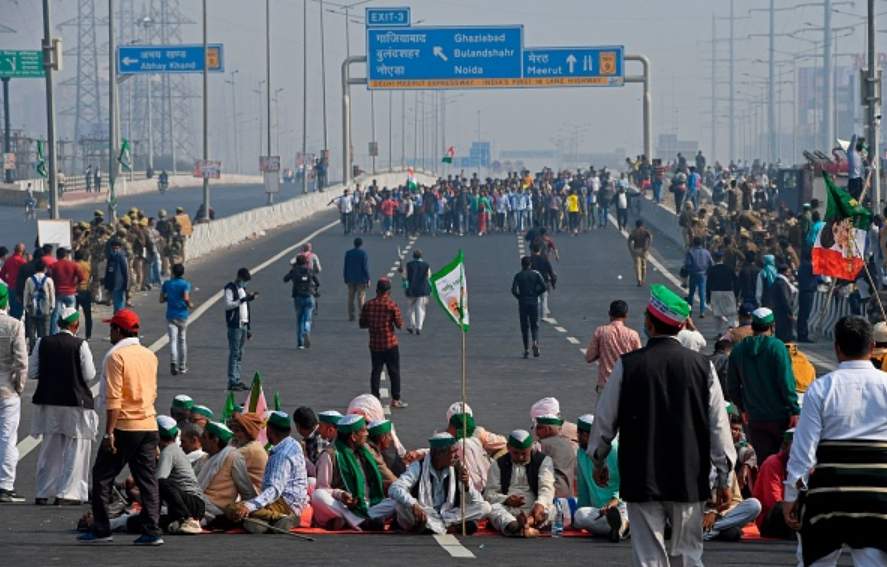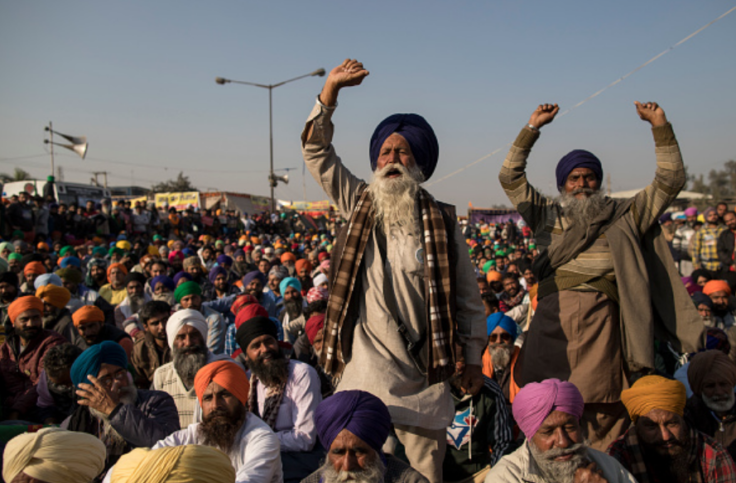
Tens of thousands of farmers from northern Indian states are camped outside the capital New Delhi to oppose the three farm laws passed by the Bharatiya Janta Party (BJP)-led government in November, making it one of the single largest protests in recent times. The farmers’ agitation highlights the undemocratic manner in which the BJP ushered in the laws, first as ordinances and later passed without parliamentary debate. While the Supreme Court has halted the implementation of these laws, the protests lay bare the poor state of the agricultural sector in a country where the majority of the population still relies on the primary sector.
What do India’s New Farm Laws say?
The three farm laws—the Farmers’ Produce Trade and Commerce (Promotion and Facilitation) Act (FPTCA), Farmers (Empowerment and Protection) Agreement of Price Assurance and Farm Services Act (FAPAFSA), and the Essential Commodities (Amendment) Act (ECA)—aim to limit government control over farm trade in a hope to increase the number of agricultural produce buyers. The laws are designed to incentivize more buyers to purchase from farmers, leading to more favorable prices for farmers.
While the Supreme Court has halted the implementation of these laws, the protests lay bare the poor state of the agricultural sector in a country where the majority of the population still relies on the primary sector.
The FAPAFSA allows for contract farming—an agreement between farmers and buyers prior to production with a guaranteed price for the produce. The law also lays down a dispute resolution mechanism, which clearly stipulates that farmers’ land not be taken for recovery of dues. This will be an important safety net for Indian farmers as falling into a debt trap and losing land holdings to lenders and commission agents, also known as arhityas, is common. The second law, the ECA, removes the imposition of stock limits on farm produce, except in extraordinary cases where there is a significant increase in prices. The most crucial, however, is the FPTCA, which allows farmers and traders to sell outside the existing state government-operated mandis (wholesale markets) and carry out electronic trading of agricultural produce. The law abolishes the existing market fees levied by state governments on farmers and traders selling/buying products outside the regulated mandis.
Why are Farmers Protesting?
The FPTCA is also the most controversial element of the new laws for one main reason—the lack of a guaranteed minimum support price (MSP). The fair price determined by the government for grains, pulses, lentils, and a handful of other crops was introduced to ensure that farmers do not incur loses. However, the new law does not offer the safety net of guaranteed MSPs to India’s farmers.
With the FPTCA law allowing sales to take place outside the mandi system, many farmers are afraid that buyers will purposely trade outside and impose disadvantageous terms on them. This is not an unfounded fear: The eastern state of Bihar scrapped its mandi system 14 years back and the disastrous impact is evident—higher price volatility, reduced crop variety as well as below MSP prices for farmers. What the BJP government ignores is that market forces yield the best results only in ideal conditions. Considering these transactions’ information asymmetry and the farmers’ poor bargaining capacity, high indebtedness, fractured farm holdings, and lack of modernized mechanisms, it is likely that the market will not be favorable to the farmers. Hence the protesting farmers’ demand that MSPs be legally mandated within and outside the mandis to protect the farmers’ interests.

The other fear is that as trade in the mandis reduces so will the tax collected by the respective states, resulting in a corresponding reduction in farm infrastructure investments by the authorities. With the legalization of contract farming, small and marginalized farmers feel that they will be sidelined by large corporations making their way into the agricultural sector. All in all, the farmers believe that the market will become more exploitative instead of more competitive.
The Politics Behind MSPs and New Laws
Despite the surging crowds around Delhi and protests by Indians around the world, the issue of MSPs largely impacts farmers of Punjab, Haryana, and to some extent Rajasthan, in North India. The reason is that the MSP is set for only a select few crops and relies on government-backed procurement.
The gains from MSP are not uniformly spread across India, which is why the farmer protests have been geographically limited. As government agencies procure the grain, farmers benefit when their respective states buy the bulk of the state’s produce. In Punjab, 95 percent of paddy farmers benefit from MSP while in neighboring Uttar Pradesh, a mere 3.6 percent of farmers do. For many small and marginalized farmers, the reality is even more grim. In absence of surplus, these farming households do not even bother going to mandis in search of competitive prices, instead sell to local buyers who offer below-MSP rates.
Even with MSP set for 23 crops, data shows that farmers receive these prices only when selling to the government, which procures primarily paddy and wheat to fuel its public distribution system (PDS), which brings the numbers to 5-6 percent of Indian farmers (although this figure has been debated, with recent research estimating that closer to 15-25 percent of farmers benefit from MSPs). As per an analysis of 10 MSP crops done in September 2020, crops were sold below the MSP in 68 percent of cases.
The debate over who earns from MSP and mandi-trade does not stop at farmers. With the new laws opening trade beyond the gates of mandis, it will exclude the lobby of arhityas who have a strong rapport with politicians in Punjab and Haryana. These agents are afraid that they will lose their 2.5 percent commission, which has been reported to total between USD $191 million to $205 million annually in Punjab alone. The states too will be staring at reduced revenue from agricultural trade once farmers and traders move out of mandis where tax is applicable.
As farmers have refused to budge and even threatened with more widespread protests, the Supreme Court has finally stepped in to put the implementation of the laws on hold and has requested farmers to call off the protests. Additionally, it has set up a committee that will review the three laws and hear from the opposing groups. However, this is unlikely to change the current situation for two reasons. First, the four-member committee is made up of individuals who have all openly supported the three laws leaving little room for fair play. Second, the Supreme Court is responsible for assessing the constitutionality of acts passed by the Indian parliament and not evaluating government policy.
The Larger Problem: A Struggling Farming Sector
While one may argue that the MSPs do not benefit a significant portion of Indian farmers, one point cannot be ignored—India’s agriculture sector is in shambles. Despite 48 percent of India’s population relying on agriculture, the sector has seen poor wage growth. Decreasing soil fertility, excessive use of groundwater and chemicals, and reduction in crop diversity make the situation worse.
Consecutive governments have set a 4 percent growth target for the sector which it has failed to achieve time and again. Tangible data reveals the extent of the agricultural sector’s crisis: 52 percent of the agricultural households in the rural India are indebted. The debt to asset ratio has jumped by an astonishing 630 percent between 1992 and 2013. The average farmer shoulders a debt of USD $642 and earns a meagre monthly income of USD $87. Farmer suicides, sadly, have also mounted in parallel to the rising debts. It is estimated that 28 people dependent on farming in India commit suicide on a daily basis.
The debt to asset ratio has jumped by an astonishing 630 percent between 1992 and 2013. The average farmer shoulders a debt of USD $642 and earns a meagre monthly income of USD $87.
With 86.2 percent of farmers holding less than two hectares of land, most farming families do not even have produce surplus to sell to the market which means that in most cases it is a hand-to-mouth situation. Poor farmers are often forced to sell their land holdings or, worse yet, have their land be taken over by money lenders seeking to recover their loans. These landless farmers are forced to work as farm laborers and migrate to other states.
What Can the Government do?
The Indian economy needs more than just three laws to reform India’s agricultural sector. A shift away from MSPs, as suggested by the new laws, must be replaced by a universal basic income (UBI) as a safeguard for farmers. Not only will a UBI provide social security to India’s farmers but it will also help reduce the high procurement, storage, and transportation costs incurred by the government as part of the MSP-PDS system. Direct cash transfers will also reduce the cuts earned by agents.
To tackle low productivity and imperfect market conditions, the sector calls for reducing information inequity, introducing area planning and incentivizing small and marginalized farmers to take up floriculture, animal rearing, and growing high-revenue crops. This requires policy intervention by the government and heavy investments. Roping in the private sector through corporate social responsibility initiatives is one way to address the problem of limited infrastructure and funds. While the BJP is in no mood to repeal the laws, introducing universal basic income for farmers and focusing on agricultural infrastructure development will help revitalize the sector.
***
Click here to read this article in Urdu.
Image 1: Prakash Singh/AFP via Getty Images
Image 2: Anindito Mukherjee via Getty Images


